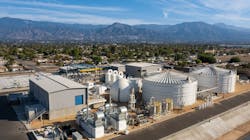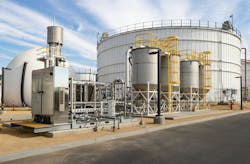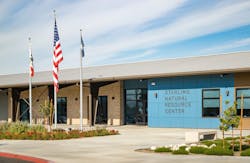Progressive design-build for wastewater treatment construction
Water treatment construction frequently involves several public and private stakeholders and can benefit greatly from a collaborative contracting method such as progressive design-build.
Relations with nearby communities and those communities’ rapidly changing needs may require design evolutions during construction. Under a progressive design-build model, all parties — owners, designers and contractors alike — are empowered to fully understand these changes and effectively collaborate through them.
Progressive design-build for a water recycling facility
Balfour Beatty, an international infrastructure company, is delivering the Sterling Natural Resource Center (SNRC) water recycling facility in San Bernadino, California, for the East Valley Water District (EVWD).
The facility plays a vital role in the region’s water infrastructure and sustainability efforts, processing 8 to 10 million gallons of water per day (MGD) and mitigating drought conditions by replenishing the Bunker Hill underground aquifer.
EVWD entrusted the Balfour Beatty team to expedite construction for the new water recycling facility. A progressive design-build contracting method enabled the company to meet that demand on an accelerated schedule, with major construction activities beginning before final designs were completed.
Contractors might typically provide a guaranteed maximum price (GMP) with roughly 60 to 70% of drawings complete. On SNRC, the team provided the district with a GMP based on less than 30% of completed designs. Shortly thereafter, Balfour Beatty mobilized excavation teams and began construction just months after submitting the proposal.
By contributing design and construction expertise as the project progressed, Balfour Beatty helped EVWD meet not only an accelerated project timeline but also their budgetary goals.
As a California Special District, EVWD is not only accountable to local ratepayers through water and wastewater rates, but also receives State grants and bonds for multiple projects. This has driven the district to embrace strong financial stewardship and transparent accountability. Both speed-to-market and budget reliability were important goals for the team to meet.
Adjusting to stakeholder changes
Wastewater treatment facilities, whether for public utility districts or private companies, often involve intricate layers of communication, management and resolution with many invested stakeholders including city councils, state authorities and regulatory agencies. On SNRC, each stakeholder had the opportunity to review and comment on the design.
Balfour Beatty’s and EVWD’s progressive design-build solutions for SNRC ensured that the team could quickly adapt to and integrate design changes while remaining within the client’s budget.
The planned discharge location became an unviable option early in design, so the team collaborated on a solution. San Bernadino Valley Municipal Water District purchased a new parcel of land for the discharge location, and SNRC developed the new routing and design to meet this change.
Because the new discharge location, Weaver Basins, was located farther away from the facility, a change order and budget revision were necessary. Again, a progressive design-build approach ensured that the teams and all stakeholders could more effectively collaborate to identify schedule impacts and perform cost analysis for the new scope.
More sustainable solid waste management
As construction of SNRC progressed, Balfour Beatty and the East Valley Water District identified several new opportunities to enhance the facility’s waste reduction capabilities, adding to its long-term community value and environmental sustainability efforts.
Though the initial design did not incorporate solid waste handling in the treatment process, EVWD made the decision to incorporate solid waste handling into the facility. SNRC takes in wastewater from the surrounding community, processes out solid waste and filters the water through membrane bioreactors, then disinfects the water with ultraviolet light before it is conveyed to the Weaver Basins.
The filtered solid waste must go somewhere, and the original project scope involved the capability to dewater and transport the solids to a nearby landfill.
The Balfour Beatty team quickly adapted to the necessary modifications and, in collaboration with equipment vendor Anaergia, designed the added solids processing infrastructure. The end result is an enhanced improvement to the facility’s sustainability. Rather than transporting solid waste to a landfill, that waste is digested into biogas then utilized to fuel a pair of combined heat and power generators that create enough energy to power the entire facility and channel any surplus back onto the electrical grid.
The teams’ effective collaboration also improved SNRC’s sustainability through the diversion of liquid food waste from landfills. This enhancement further fuels the facility’s biogas reactors and its overall power output.
Employing wildlife preservation methods
Building the SNRC also involved a high degree of sensitivity to local wildlife.
The area is home to large populations of the San Bernadino Kangaroo Rat, a gerbil-like rodent and the focus of extensive conservation efforts by federal and state wildlife agencies. In collaboration with the client, Balfour Beatty identified the ecological importance of this species early on and incorporated substantial mitigation measures into the designs and earliest GMP estimates.
Silt fences, rat fences and other deterrents helped ensure that kangaroo rat populations were repelled from the project site, thus avoiding any undue harm to a species already significantly affected by human development and community expansion.
The team developed creative solutions to protect other local wildlife, including the Santa Ana River woolly star flower, the silver-horned spine flower and the California gnatcatcher bird. Each is a federally designated endangered species, and each is a vital component of the local ecosystem.
Progressive success
The Sterling Natural Resource Center ultimately stands as a progressive design-build success story — a testament to the power of early collaboration, innovation and communication between a contractor and all stakeholders.
Under a progressive design-build methodology, all parties are equipped and empowered to thrive, innovate and achieve excellence.
About the Author
Tom Murray
With more than 38 years of experience in the construction industry, Tom Murray serves as Balfour Beatty senior project manager in California. A part of the company’s U.S. Civils business, Tom leads teams in the delivery of water infrastructure projects on behalf of local water departments to provide communities with access to clean, sustainable water solutions.



